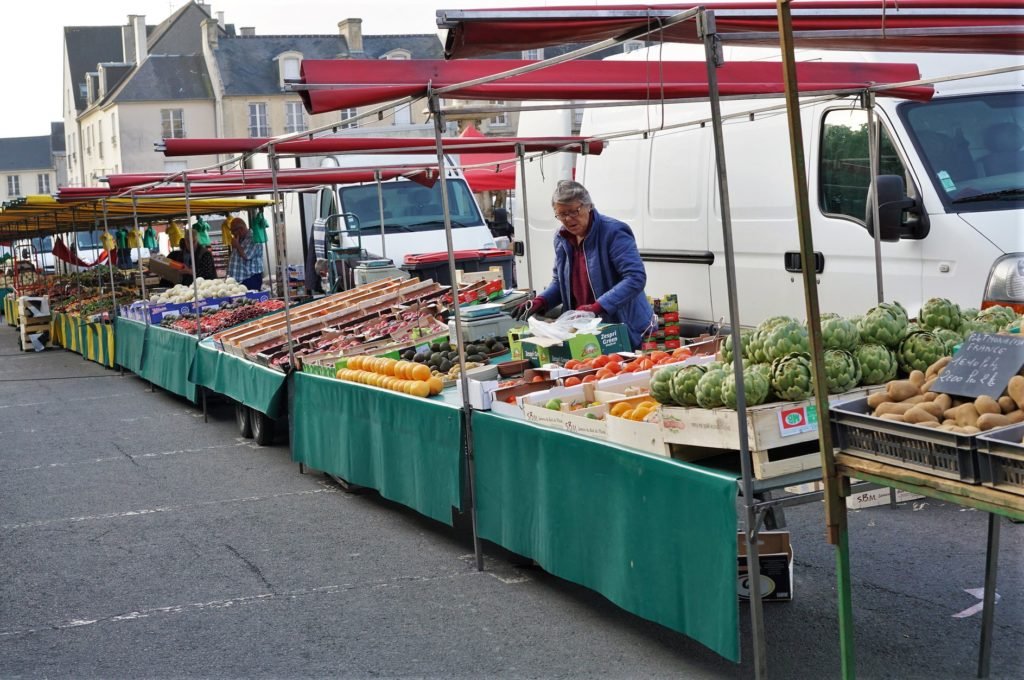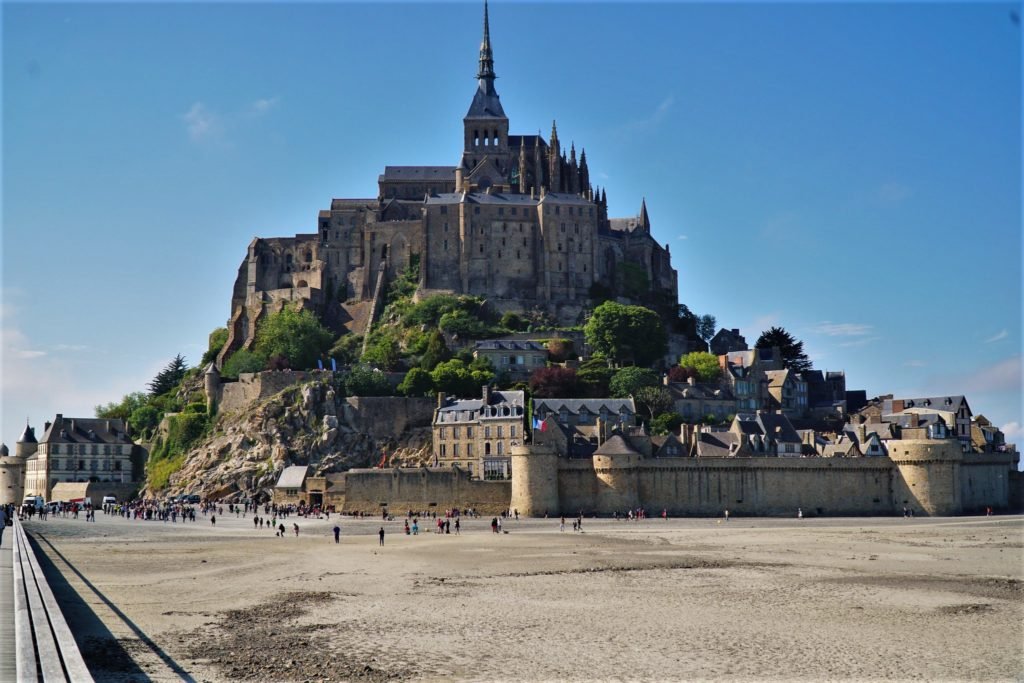We woke up in Bayeux and had a busy day ahead of us. The plan was to explore not only the sights in Normandy but also those in neighboring Bretagne.
But first things first—breakfast at a Saturday market.
Visiting a Saturday market is one of those truly not-to-be-missed French experiences. There is simply no better way to start a day. Our first French Saturday market was in 2009 in Rouen, followed by another in Amboise in 2016. Both times, we mingled with locals, chatted with friendly farmers, and sampled different types of cheese, foie gras, fruit, and bread.
In Bayeux, we headed to the town center early when vendors were still unpacking their wares and setting up their stands. This was a warm, sunny Saturday in May, and a little cobblestone square was soon busy with residents going about their weekend shopping.
When we got to the market, I was immediately struck by how many locals carried small woven baskets filled with produce and freshly baked baguettes. I was mesmerized. I was staring at these cute baskets and suddenly had an idea.
“Hey, what do you think if we buy a basket for our grocery shopping back home?” I asked Julia.
“Are you serious?” Julia was incredulous.
“What, why not?”
“You'll look ridiculous. You will not be doing grocery shopping in a French town on a sunny summer day. If you show up with this basket at Costco on a freezing day in Chicago, people will think you're a weirdo."
She probably had a point. But, even a year later, I still can’t get those woven baskets out of my head.

Camembert and goat cheese, croissants, apple brandy-soaked pastries, and two cups of freshly brewed coffee—our breakfast was glorious. We parked ourselves on the curb and munched on these goodies while people-watching the bustling Saturday market.
“Should we also try oysters?" Julia was clearly not ready to leave the market. "The English Channel is just five miles from here; they should be fresh and cheap.”
I had no objections.
The oyster stand was nearby and next to the flower stand. The aroma of freshly cut flowers mixed with the briny smell of the sea created the atmosphere of a tropical paradise right in the center of this French town. We went for eight medium-sized oysters that had been picked from the seabed just a few hours earlier. The entire order came to around $7, a real steal. I had oysters before and wasn't a big fan. But these oysters were a game-changer and the tastiest I've ever had.
“After trying oysters here, I don’t think I can eat them anywhere else.” I sadly confessed to Julia as I slurped the last of the oysters.


Saying goodbye to baskets and oysters, we left Bayeux and drove west to Dinan in the Bretagne province.
Dinan is a delightful hilltop medieval town where movies based on Alexander Dumas's novels can be easily filmed. Traditional half-timber houses, picturesque cobblestone streets, and flavorful buckwheat crepes, Dinan had it all. Even the traditional white bonnets that I'd first seen in Paul Gauguin's paintings were sold here in gift shops. The only regret: not having more time in Bretagne to visit other places along its rugged coastline, like St. Malo or Dinard.



After several hours in Dinan, we headed back to Normandy to make it to Mont Saint-Michel by late afternoon. The timing was important. The postcard-pretty abbey is a very popular place and is overrun with tourists. When we arrived at the abbey walls at 5 p.m., there were still small crowds there. We could only imagine what this place looked like in the middle of the day.
The fortress-like abbey is impressive and feels almost Disney-esque. We visited in May, and the surrounding plains weren't flooded this time of the year. Although we did go inside and walk Mont Saint-Michel’s walls and labyrinth-like streets, the best views were from the expansive fields outside the abbey walls.
In the last post, we described how we splurged on fancy meals in Normandy, but Mont Saint-Michel found a new way to shock us. Here is a question: Would you pay $120 for two omelets? Because that’s the price for two omelets de la mère Poulard.
Back in the day, incoming tides flooded the roads to the island abbey, and pilgrims often had no time to wait for food preparation or a sit-down meal. In the 19th century, the local woman, Madame Poulard, solved the problem by creating at her restaurant a quickly prepared, to-go fluffy omelet.
We stopped by the original restaurant to learn about this world-famous dish and watched quick-handed cooks beating dozens of eggs in a large metal bowl into a high froth and pouring it into sizzling skillets. Apparently, royalty, high-level officials, and politicians, including U.S. presidents, all eat this omelet when visiting Mont Saint-Michel, probably due to a rumored superstition that failing to eat it during a political campaign guarantees a defeat.
But $60 for an omelet? Madame Poulard would probably be very surprised by how much money is charged for her creation now. The inflated price defeated even our splurging attitudes. Instead, we split a cheaper “abbey” version for $30 from a nearby restaurant that copied the “secret” recipe. Although it was just as fluffy and delicious as advertised, even the cheaper version was still ridiculously overpriced.
Our advice: if you can eat somewhere before or after visiting the abbey, do so. With limited options and thousands of daily tourists, the supply and demand drive food prices at the abbey to shocking levels.



After bidding goodbye to the majestically lit Mont Saint-Michel rising out of the darkness, we returned to our Airbnb in Bayeux at midnight.
We spent three days eating the most delicious food France could provide and seeing some of the best French sights. Everything was going to change the next day. That last day in France was the reason for our entire visit, and it was a sobering reminder of just how fleeting all of life’s pleasures truly are.
Coming Up Next: Tour of D-Day Beaches on the 75th Anniversary Battle of Normandy.

